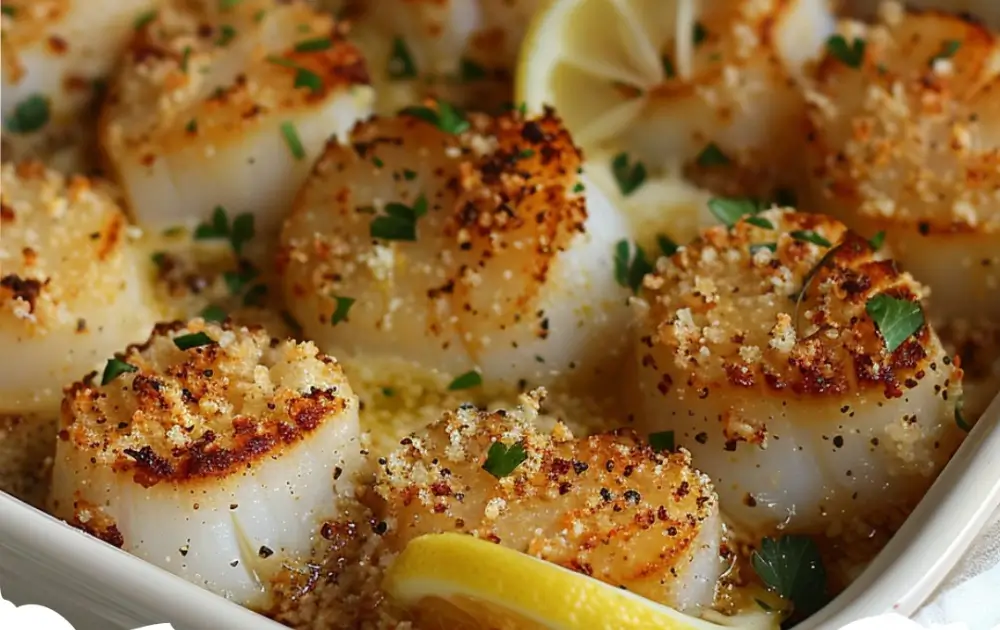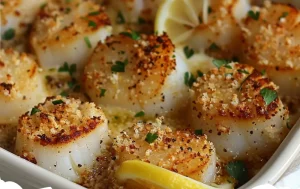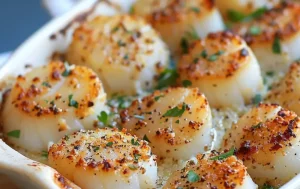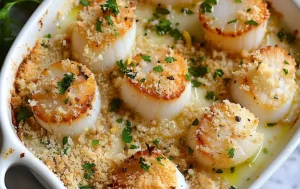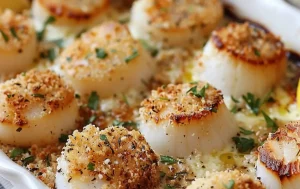Baked Scallops are a sophisticated and elegant seafood dish that is both simple to prepare and delightful to eat. These mollusks are known for their delicate texture and sweet, rich flavor, which make them a favorite among seafood lovers. Baking scallops helps to preserve their tender texture while infusing them with the flavors of the accompanying seasonings and ingredients. This cooking method is ideal for highlighting the natural beauty of scallops, making them a perfect choice for special occasions or a gourmet weeknight dinner.
Print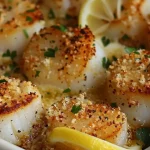
Baked Scallops
- Author: recipstep
- Total Time: 25 minutes
- Yield: 4 servings
- Diet: Gluten Free
Description
Baked Scallops are a gourmet seafood dish known for their rich, buttery flavor and tender texture. This recipe brings out the natural sweetness of scallops, complemented by a light seasoning of garlic, herbs, and Parmesan, all baked to perfection.
Ingredients
▢olive oil spray
▢16 large, 1 pound large sea scallops
▢1/4 cup panko crumbs
▢1 1/2 tablespoons grated Parmesan cheese
▢1 tablespoon fresh minced parsley
▢1/4 teaspoon dried oregano
▢1/4 kosher teaspoon salt, divided
▢fresh black pepper, to taste
▢Juice of 1 lemon, divided
▢2 1/2 tablespoons melted unsalted butter
Instructions
Preheat the oven to 400°F and lightly spray an 8 x 10-inch oval baking dish or 2-quart gratin dish with olive oil or nonstick cooking spray.
Pat the scallops dry then spritz them with a little oil, season with 1/8 teaspoon salt.
In a small bowl combine the panko, Parmesan, parsley, oregano, 1/8 teaspoon salt and black pepper, to taste.
Arrange the scallops in a single layer in the prepared dish. Top with the crumb mixture.
Whisk half of the lemon juice, melted butter together and pour over the scallops.
Bake for 15 minutes, or until the scallops are opaque.
Set the oven to broil on high and broil second rack from the top until the topping is golden, about 2 to 3 minutes.
Squeeze the remaining lemon over the scallops and eat right away.
Notes
- Ensure scallops are dry before seasoning to maximize flavor absorption.
- If using frozen scallops, thaw completely and dry before use.
- Overcooking can make scallops rubbery, so it’s essential to watch the cooking time closely.
- Gluten-Free (if using gluten-free breadcrumbs).
- Prep Time: 10 minutes
- Cook Time: 15 minutes
- Category: Main Course
- Method: Baking
- Cuisine: American
Nutrition
- Calories: 220
- Sugar: 0.5g
- Sodium: 540mg
- Fat: 9g
- Saturated Fat: 5g
- Carbohydrates: 10g
- Fiber: 0g
- Protein: 25g
- Cholesterol: 55mg
Frequently Asked Questions (FAQs)
How do I know if scallops are fresh?
Fresh scallops should have a slightly sweet, mild oceanic smell. They should be firm to the touch and have a moist appearance without being overly slimy. Any discoloration or strong fishy odor indicates that the scallops are not fresh.
Can I use frozen scallops for this recipe?
Yes, frozen scallops can be used for baking. Thaw them in the refrigerator overnight before use. Pat them dry thoroughly with paper towels to remove excess moisture. This helps to achieve a better sear and prevents the scallops from becoming watery when baked.
What are the best herbs to use with baked scallops?
Delicate herbs like parsley, tarragon, and chives work well with baked scallops as they complement without overpowering the subtle flavor of the seafood. For a bolder taste, you can use thyme, rosemary, or oregano.
Is it necessary to remove the muscle from scallops?
Yes, it’s advisable to remove the small, tough side muscle from scallops before cooking. This muscle can be chewy and detracts from the otherwise tender texture of the scallops. It peels off easily with your fingers.
How can I prevent scallops from becoming rubbery when baked?
To prevent scallops from becoming rubbery, avoid overcooking them. Bake just until they are opaque and slightly firm to the touch, which typically takes about 10-12 minutes at 400 degrees Fahrenheit. Overcooking will toughen the scallops and diminish their natural juiciness.
Choosing and Preparing Scallops
When selecting scallops for baking, it’s important to look for ones that are firm, slightly moist, and have a translucent, creamy white color. Fresh scallops should have a mild scent reminiscent of the ocean; any strong fishy smell is a sign they are not fresh. Prior to baking, scallops must be rinsed under cold water and patted dry with paper towels. Removing the small side muscle, which can be tough when cooked, is a crucial step in the preparation process.
Seasoning and Flavoring
To enhance their natural sweetness, scallops can be seasoned with a variety of herbs and spices. A classic approach involves using butter, garlic, and fresh herbs such as parsley and thyme. For a touch of brightness, a squeeze of lemon juice is often added before baking. Other popular flavorings include white wine, which adds a nice acidity, and breadcrumbs or Parmesan cheese for a gratin-style topping that adds texture and richness to the dish.
Baking Techniques
The key to perfectly baked scallops is not overcooking them, as they can become tough and rubbery if left in the oven too long. Scallops should be baked in a preheated oven at around 400 degrees Fahrenheit for about 10-12 minutes, just until they are opaque and slightly firm to the touch. Arranging scallops in a single layer in a buttered baking dish ensures they cook evenly. Covering the dish with foil can help keep them moist, but removing the foil towards the end of cooking allows the top to brown and crisp up slightly.
Serving Suggestions
Baked scallops are incredibly versatile and can be served in a variety of ways. They pair beautifully with light pasta dishes, such as linguine tossed with olive oil and herbs. For a low-carb option, serving them alongside a fresh green salad or steamed vegetables makes for a balanced meal. To enhance their decadence, a side of creamy risotto or a simple potato gratin can match the richness of the scallops. Wine pairings such as a chilled Chardonnay or a crisp Sauvignon Blanc complement the flavors of baked scallops splendidly.
Variations and Modern Adaptations
Chefs and home cooks alike enjoy experimenting with different ingredients to create unique variations of baked scallops. Adding a crust made from crushed nuts or incorporating elements like chorizo or smoked bacon can introduce new textures and flavors to the dish. For those who enjoy a little heat, a sprinkle of crushed red pepper flakes or a dab of spicy aioli on top before serving can add a vibrant kick. Another modern twist involves using coconut milk and curry spices for an exotic, tropical flavor profile that still respects the delicate nature of the scallops.
Dietary Considerations
Baked Scallops are naturally low in fat and high in protein, making them an excellent choice for those looking to maintain a healthy diet. They are also rich in omega-3 fatty acids, which are crucial for heart health and brain function. For those on a gluten-free diet, ensure that any added breadcrumbs are gluten-free or substitute with crushed nuts or gluten-free crackers for a crunchy topping. Additionally, scallops are a good source of minerals such as magnesium and potassium, which are important for muscle and nerve function.
Storage and Reheating Tips
Proper storage is key to maintaining the quality of baked scallops. If there are leftovers, they should be stored in an airtight container in the refrigerator and consumed within two days. When reheating, it is best to do so gently to avoid overcooking the scallops. Using a low temperature in the oven or even briefly warming them in a pan over low heat can help preserve their tender texture. Microwaving is not recommended as it can quickly turn the scallops rubbery.
Presentation Techniques
Presentation can significantly enhance the dining experience, especially with a dish as elegant as baked scallops. Consider serving them in their shells for a natural and impressive presentation. Garnish with a sprinkle of finely chopped herbs, lemon zest, or a drizzle of infused oil to add color and enhance flavor. Plating scallops on a bed of sautéed greens or alongside sculpted vegetables can also elevate the visual appeal and add a gourmet touch to the meal.
Seasonal Pairings
Baked scallops can be adapted to fit seasonal ingredients and themes. In the spring, pairing them with fresh peas and mint can bring a light freshness to the dish. During summer, a side of zesty quinoa salad with citrus dressing complements the scallops’ richness. In the fall, accompany them with roasted squash or a pumpkin puree to introduce a comforting warmth. For winter, serving baked scallops with a root vegetable mash or alongside a hearty grain like farro can provide a satisfying and warming meal.
Advanced Cooking Techniques
For those looking to experiment further, consider incorporating advanced cooking techniques such as sous-vide before baking to achieve precise doneness. This method involves vacuum-sealing the scallops and cooking them in a water bath at a controlled temperature, then quickly searing or baking them for a golden finish. Another technique is to incorporate a sabayon or hollandaise sauce as a topping before the final broiling step to add a luxurious richness to the dish. Additionally, playing with smoky flavors using a touch of liquid smoke or a brief pre-sear on a very hot, dry pan can introduce an intriguing layer of taste to the scallops.
Nutritional Benefits
Baked Scallops are a powerhouse of essential nutrients that contribute to a balanced diet. They are an excellent source of high-quality protein, vital for building and repairing tissues in the body. Scallops are also low in calories, making them an ideal choice for weight management plans. Rich in vitamins B12 and D, scallops support nerve health and bone strength, respectively. Additionally, they contain trace minerals like selenium and zinc, which are important for immune system function and metabolism.
Creative Flavor Infusions
Experimenting with flavor infusions can transform the simple dish of baked scallops into a culinary masterpiece. Introducing aromatic ingredients such as lemongrass, ginger, or fennel during the baking process can impart subtle yet distinct flavors. Incorporating infused oils, such as basil or garlic oil, before serving can enhance the aroma and taste of the dish. Even a dash of fine spirits, like a spoonful of cognac or white wine, added just before finishing in the oven, can provide a flavorful deglaze that complements the scallops’ natural sweetness.
Hosting and Entertaining
When hosting an event, baked scallops make for a sophisticated and impressive dish that can be prepared ahead of time, allowing you to enjoy your guests’ company without last-minute preparation. For a visually appealing display, arrange scallops on a platter garnished with edible flowers and microgreens. Pairing the meal with appropriate wines, such as a light Pinot Gris or a sparkling Prosecco, can greatly enhance the dining experience. Providing guests with individual portions on small, elegant plates or in scallop shells can make the meal feel more personalized and special.
Eco-Friendly Seafood Practices
Choosing scallops that have been responsibly sourced is crucial for maintaining ocean health. Opt for scallops certified by marine conservation organizations, which often indicate sustainable practices. When purchasing scallops, ask vendors about the origin and the method of harvest—wild-caught scallops from managed fisheries or those farmed through aquaculture are generally more sustainable options. Being conscious of these choices helps preserve marine biodiversity and ensures the longevity of seafood supplies.
Alternative Dietary Options
Baked scallops can be adapted to suit various dietary needs without compromising on flavor or texture. For a dairy-free version, replace butter with high-quality olive oil or coconut oil, which will still allow for a rich, caramelized finish. For those avoiding garlic or onions, aromatic alternatives like chives, tarragon, or a sprinkle of smoked paprika can be used. Utilizing gluten-free toppings, such as crushed gluten-free crackers or almond meal, instead of traditional breadcrumbs, ensures those with gluten sensitivities can also enjoy this delicious dish.
Conclusion
Baked scallops are a delightful treat that blends elegance with simplicity, making them a versatile dish suitable for both casual and formal occasions. By selecting quality ingredients and following the tips provided, you can ensure your scallops are cooked perfectly every time. Whether served as a sophisticated starter or as part of a main course, baked scallops offer a seafood experience that is not only delicious but also nutritionally beneficial. Embrace the opportunity to experiment with different herbs and seasonings to tailor the dish to your taste preferences and dietary needs, ensuring that these baked scallops will impress any diner with their delightful flavors and elegant presentation.

